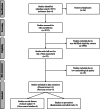Risk factors and prevention strategies for shoulder injuries in overhead sports: an updated systematic review
- PMID: 35971013
- PMCID: PMC9378805
- DOI: 10.1186/s40634-022-00493-9
Risk factors and prevention strategies for shoulder injuries in overhead sports: an updated systematic review
Abstract
Purpose: The aim of this systematic review was to update the knowledge on risk factors and prevention strategies for shoulder injuries in overhead sports with special emphasis on methodological quality.
Methods: All methodological procedures were performed in line with a previous systematic review by Asker et al. (2018). The literature search was conducted in the PubMed, Google Scholar, Cochrane, and SPORT-Discuss databases. Due to the risk of bias assessment, only studies with at least an acceptable methodological quality were included. A best-evidence synthesis was performed to clarify the evidence and direction of the risk factors and prevention strategies.
Results: A total of nine studies were included in the data extraction process. One study had a high and eight studies had an acceptable methodological quality. Seven cohort studies investigated risk factors and two randomised controlled trails evaluated prevention strategies. Moderate evidence was found for two non-modifiable (playing position, gender) and three modifiable factors (shoulder rotational strength, scapular dyskinesia, shoulder prevention programme) that were associated with the shoulder injury risk. All further risk factors had moderate and no association with risk (shoulder rotational ROM, joint position sense) or limited (history of shoulder/elbow pain, age, training experience, training volume, school grade, playing level), and conflicting evidence (setting).
Conclusions: There is moderate evidence for two non-modifiable (playing position, gender) and three modifiable factors (shoulder rotational strength, scapular dyskinesia, shoulder prevention programme) being associated with the shoulder injury risk in overhead sports.
Keywords: Baseball; Handball; Joint instability; Long biceps tendinosis; Overuse injuries; Rehabilitation; Return to sports; Rotator cuff lesion; Shoulder pain; Tennis.
© 2022. The Author(s).
Conflict of interest statement
The authors declare no competing interests.
Figures
Similar articles
-
Risk factors for shoulder injuries in handball: systematic review.BMC Sports Sci Med Rehabil. 2022 Dec 2;14(1):204. doi: 10.1186/s13102-022-00588-x. BMC Sports Sci Med Rehabil. 2022. PMID: 36461053 Free PMC article.
-
Risk Factors of Overuse Shoulder Injuries in Overhead Athletes: A Systematic Review.Sports Health. 2020 Sep/Oct;12(5):478-487. doi: 10.1177/1941738120931764. Epub 2020 Aug 6. Sports Health. 2020. PMID: 32758080 Free PMC article.
-
DESCRIPTIVE PROFILE OF SHOULDER RANGE OF MOTION AND STRENGTH IN YOUTH ATHLETES PARTICIPATING IN OVERHEAD SPORTS.Int J Sports Phys Ther. 2020 Dec;15(6):1090-1098. doi: 10.26603/ijspt20201090. Int J Sports Phys Ther. 2020. PMID: 33344026 Free PMC article.
-
Risk Factors Associated with New Onset of Shoulder Pain and Injury Among the Athletic Population: A Systematic Review of the Literature.Int J Sports Phys Ther. 2025 Mar 1;20(3):315-332. doi: 10.26603/001c.129462. eCollection 2025. Int J Sports Phys Ther. 2025. PMID: 40041538 Free PMC article.
-
Age-related, sport-specific adaptions of the shoulder girdle in elite adolescent tennis players.J Athl Train. 2014 Sep-Oct;49(5):647-53. doi: 10.4085/1062-6050-49.3.02. Epub 2014 Aug 6. J Athl Train. 2014. PMID: 25098662 Free PMC article.
Cited by
-
Effectiveness of a sport-specific exercise programme for overhead athletes with unilateral subacromial shoulder pain: a study protocol of a randomised controlled trial.BMJ Open Sport Exerc Med. 2025 Mar 13;11(1):e002523. doi: 10.1136/bmjsem-2025-002523. eCollection 2025. BMJ Open Sport Exerc Med. 2025. PMID: 40092169 Free PMC article.
-
Musculoskeletal, Functional and Performance Impairment in Female Overhead Athletes with a Previous Shoulder Injury.Healthcare (Basel). 2023 Dec 21;12(1):21. doi: 10.3390/healthcare12010021. Healthcare (Basel). 2023. PMID: 38200927 Free PMC article.
-
Establishing Normative Values for Acromion Anatomy: A Comprehensive MRI-Based Study in a Healthy Population of 996 Participants.Diagnostics (Basel). 2024 Jan 3;14(1):107. doi: 10.3390/diagnostics14010107. Diagnostics (Basel). 2024. PMID: 38201416 Free PMC article.
-
Effects of Digital Physical Health Exercises on Musculoskeletal Diseases: Systematic Review With Best-Evidence Synthesis.JMIR Mhealth Uhealth. 2024 Jan 23;12:e50616. doi: 10.2196/50616. JMIR Mhealth Uhealth. 2024. PMID: 38261356 Free PMC article.
-
Effect of isokinetic eccentric training on the human shoulder strength, flexibility, and muscle architecture in physically active men: A preliminary study.PLoS One. 2023 Dec 19;18(12):e0293439. doi: 10.1371/journal.pone.0293439. eCollection 2023. PLoS One. 2023. PMID: 38113203 Free PMC article.
References
Publication types
LinkOut - more resources
Full Text Sources


